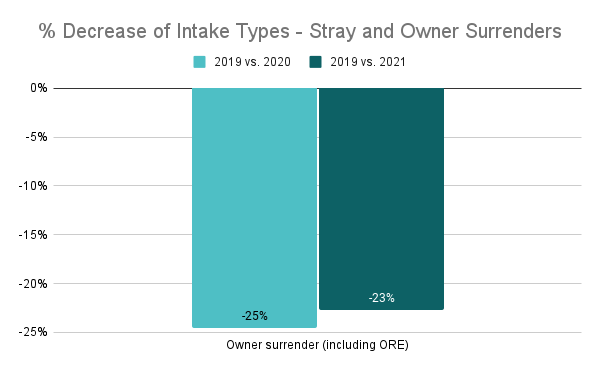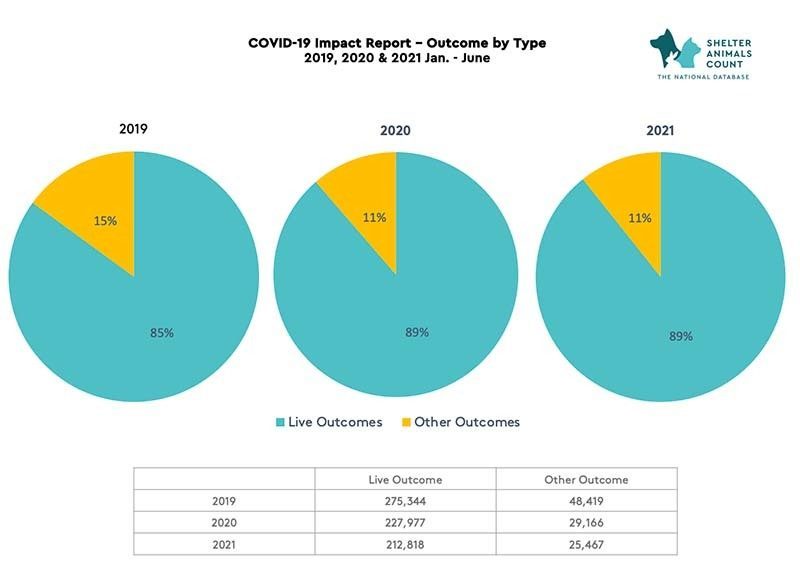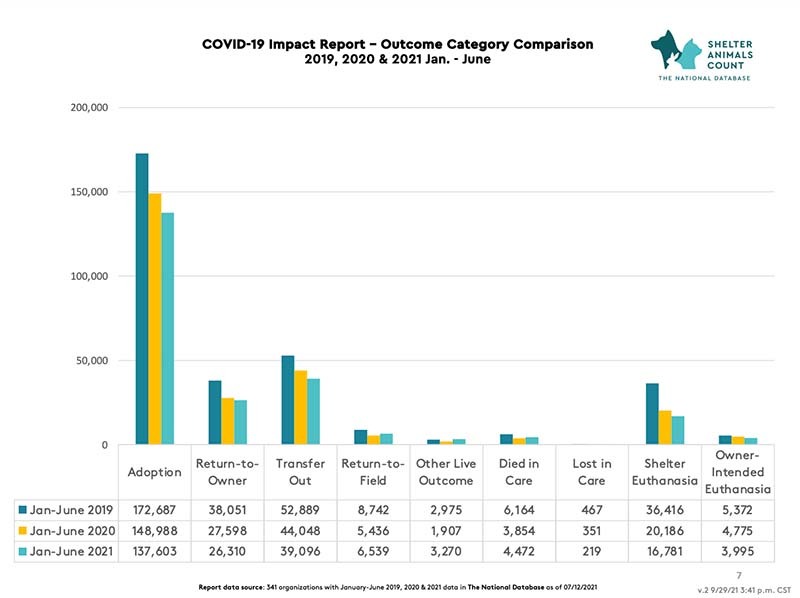American Pets Alive! Blog: THE DATA'S IN: NO, 'PANDEMIC PETS' WEREN'T RETURNED TO SHELTERS—BUT SHELTERS DO NEED HELP
- Home
- THE DATA’S IN: NO, ‘PANDEMIC PETS’ WEREN’T RETURNED TO SHELTERS—BUT SHELTERS DO NEED HELP

30Sep’21
American Pets Alive! Blog
By: Arin Greenwood
“Everyone wanted a puppy when the pandemic began, but now those dogs are being returned,” screamed USA Today this past May.
“Pets adopted during the pandemic are being returned in record numbers,” warned the New York Post, the very same day.
Call it the pandemic pet panic. We all saw the many alarming and sensationalist media reports last spring—with the underlying judgment that it was bad for people to adopt shelter pets.
We already knew the judgment part of all this was wrong. Adopting shelter pets is, in a word, good. (In two words it’s freaking awesome. We could go on.)
Now we’ve got the data to show those terrible headlines simply aren’t true, either.
“Pandemic pets” have not been returned to shelters in droves and we’ve got the numbers to prove it, courtesy of Shelter Animals Count’s brand new report looking at shelter data from 2019, 2020, and 2021.
The data shows intakes—the number of animals entering shelters—are still sharply down from where they were before the pandemic, while the adoption rate is up. Nearly 90 percent of animals entering U.S. shelters are leaving alive, up from before the pandemic.
Shelter Animals Count is an independent nonprofit organization that runs The National Database to collect, aggregate, and analyze data from animal shelters across the country.
SAC got data from 341 organizations, to run raw numbers and trends for January through June of 2019, 2020, and 2021. They compared what’s been happening in shelters for the first half of every year, over the last three years. (They have upcoming studies planned, covering more of each year.)
The chart below, created by SAC, shows what they found:

This chart appears on page four of the Shelter Animals Count report.
As you can see, 2021 intake is still well below 2019.
Digging in: From 2019 to 2021, there is a nearly 25 percent drop in intakes over the relevant time periods. From 2020 to 2021, the number of intakes increased by .56 percent; not even 1 percent.

This chart appears on page five of the Shelter Animals Count report.
Bear with a bunch of numbers here: Between 2019 and 2021, SAC found a 22.9 percent decrease in owner surrendered pets—pets given up to animal shelters by their owners, including owners requesting euthanasia for their pets from the shelter.
That breaks down to a 25.1 percent decrease between 2019 and 2020, then just a 3 percent rise in surrenders in the first half of 2021 from the 2020 numbers.

This chart was created by Rory Adams of American Pets Alive! to illustrate SAC’s findings. Rory also contributed data analysis to this piece.
These are not the numbers you’d expect to see, if the pet-return “trends” being reported in the media were remotely accurate. Remember: those pandemic pet panic stories came out during the period SAC examined.
Again contrary to the alarmist headlines, SAC found fewer pets entering shelters, and that those who do have a better chance of making it out alive and into homes.
The data shows live outcomes—the number of pets who leave the shelter alive—are up, as a percentage of overall intake.
In 2019, 85 percent of shelter pets had live outcomes. In 2020, that was up to 88.7 percent. In 2021, that number is 89.3 percent. (Both have been rounded to 89 percent in the SAC chart below.)

This chart appears on page nine of the Shelter Animals Count report.
These rates do not exclude any outcomes—sometimes live release outcomes can appear higher by excluding owner-requested euthanasias. This is a true comparison of actual live release rates, including owner-requested euthanasias.
Matching these numbers up with the adoption data, we could infer the animals who were historically euthanized are now being adopted or transferred into receiving shelters.
And indeed, while lower intake means fewer animals available to be adopted—the data shows a greater percentage of the animals in shelters are getting adopted.
Let’s get specific: In 2019, 53.3 percent of shelter pets were getting adopted, in 2020 it was 57.9, and in 2021 that’s 57.7 percent of total intake.

This chart appears on page eight of the Shelter Animals Count report.
Why? One theory is that due to fewer animals needing care, shelter workers may have more time to learn about, market, and place the animals.

This chart appears on page seven of the Shelter Animals Count report.
Three other interesting tidbits:
- Stray intake decreased 28 percent in 2020, from 2019. It’s increased just .3 percent in 2021. We can guess the 2020 decrease is because of a combination of reduced animal services during the pandemic’s first year, and more people being home keeping an eye on their pets. It’s not clear yet why that number has held in 2021. Could the message for people to keep lost pets in the neighborhoods where they are found, instead of bringing them to shelters, to help get them home to their owners be working?
- Shelter euthanasia has continued to decrease through 2020 and into 2021. In 2021, 8.72 percent of all outcomes were shelter euthanasia, including owner requests for euthanasia, during the examined period. That number was 12.9 percent in 2019, and 9.7 percent in 2020. (Note that Shelter Animals Count separated shelter euthanasia from euthanasia requested by a pet’s owner in their chart, though both are included in overall rates.)
- Owner requests for euthanasia also dropped. We saw an 11.11 percent decrease in animals euthanized by the request of their owners between 2019 and 2020, and a decrease of 16.34 percent between 2020 and 2021.
There’s a lot more to discover in the report. We really recommend checking it out on the SAC website.
With all that: First, while the data runs counter to the alarmist headlines, it still demonstrates the urgency of Human Animal Support Services’ work and mission to keep pets and people together, and pets out of shelters.
Second, the data ends in June 2021. We have heard from people working in shelters all over the country that this has been an incredibly busy summer.
We don’t yet know what that looks like in terms of data, but SAC tells us they think there is a good explanation. After the relative lull of 2020, 2021’s raised intake numbers feel very large even if and when they are lower than in some previous years.
This feeling is exacerbated by the understaffing reported at many animal shelters. Fewer people are caring for more animals. This combination puts both people and animals at risk.
What this means is that shelters are still in critical need of fosters, adopters, and transport partners—especially for big and medium sized dogs. This need is only going to grow more urgent as more families, including pets, lose their homes to eviction.
So, in sum: No, for pete’s sake, people did not give up their “pandemic pets.” Shelters did not fill with returned puppies and kittens, cats and dogs.
But there are still wonderful cats and dogs in shelters all over the country, who’d be much better off in a home. Perhaps yours?
A final note: SAC tells us they are planning another report that looks at data from January through September of 2019, 2020, and 2021, breaking it out by species, organization type, and region.
There were, as said above, 341 organizations participating in this survey—government shelters, government contracted shelters, and nonprofit organizations. The data and trend analysis will only get better with more participation. Animal shelters and rescue groups can register here.
Join the Human Animal Support Services project and help keep more pets out of shelters, and with people!
Categories
Archives
- April 2025(1)
- March 2025(1)
- February 2025(6)
- December 2024(4)
- November 2024(2)
- October 2024(4)
- September 2024(3)
- August 2024(2)
- July 2024(3)
- June 2024(4)
- May 2024(5)
- April 2024(6)
- March 2024(6)
- February 2024(16)
- January 2024(10)
- December 2023(9)
- November 2023(5)
- October 2023(1)
- September 2023(8)
- August 2023(7)
- July 2023(3)
- June 2023(4)
- May 2023(3)
- April 2023(2)
- March 2023(8)
- February 2023(7)
- January 2023(9)
- December 2022(5)
- November 2022(3)
- October 2022(3)
- September 2022(7)
- August 2022(5)
- July 2022(5)
- June 2022(3)
- May 2022(3)
- April 2022(5)
- March 2022(6)
- February 2022(2)
- January 2022(2)
- December 2021(2)
- November 2021(3)
- October 2021(6)
- September 2021(3)
- August 2021(1)
- June 2021(1)
- October 2017(1)
- December 2015(1)
